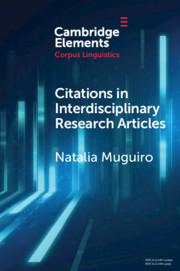Element contents
Citations in Interdisciplinary Research Articles
Published online by Cambridge University Press: 02 November 2020
Summary
Keywords
- Type
- Element
- Information
- Series: Elements in Corpus LinguisticsOnline ISBN: 9781108886086Publisher: Cambridge University PressPrint publication: 03 December 2020
References
- 9
- Cited by

